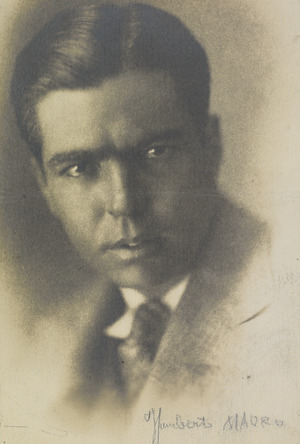Humberto Mauro facts for kids
Quick facts for kids
Humberto Mauro
|
|
|---|---|
 |
|
| Born | 30 April 1897 Volta Grande, Minas Gerais, Brazil
|
| Died | 5 November 1983 (aged 86) Volta Grande
|
| Occupation | film director, screenwriter, cinematographer |
| Spouse(s) | Dona Bebê (Maria Vilela de Almeida, Lola Lys) |
Humberto Duarte Mauro (born April 30, 1897 – died November 5, 1983) was a famous Brazilian film director. He is best known for his movie Ganga Bruta. Many people think he was the most important director in the early days of Brazilian movies.
Contents
Humberto Mauro's Film Career
Humberto Mauro made many important movies. His second film, Thesouro Perdido (which means "Lost Treasure"), won the "Film of the Year" award in Brazil in 1927. Later that year, the film company Phebo Sul America Film changed its name to Phebo Brasil Film.
The first movie released by the new company was Braza Dormida (meaning "Sleeping Ember"). This film was very popular and helped Mauro become one of Brazil's top directors.
Working with Carmen Santos
In July 1929, Mauro's last film for Phebo Brasil Film, Sangue Mineiro (meaning "Blood of Minas Gerais"), was shown. In 1930, this movie was released all over Brazil. People loved it, and critics praised it. This was the first time Mauro worked with Carmen Santos, who would later star in many of his films.
Moving to Cinédia
Phebo Brasil Film did not have enough money to keep making movies. So, Adhemar Gonzaga offered Mauro a job at Cinédia, a film company in Rio de Janeiro.
Gonzaga had started a movie called Lábios sem Beijos (meaning "Lips Without Kisses"), starring Carmen Santos. But Carmen became pregnant and could not finish the movie. Gonzaga gave the project to Mauro in March 1930. Mauro decided to make the film silent, even though sound movies were becoming popular. He wanted to explore what he could do with silent films. When it came out in 1930, the movie won the Jornal do Brasil film of the year award. Mauro also worked as the cinematographer (the person who films the movie) for Cinédia's second movie, Mulher (meaning "Woman").
Making Ganga Bruta
Mauro began filming Ganga Bruta in September 1931. The movie took a long time to finish, until 1933, because some actors had to be replaced. This film was a silent film at first. Later, synchronized sound was added using special discs. The movie was not very popular when it first came out. But about 20 years later, people started to appreciate it a lot.
First Talking Films and Documentaries
Mauro co-directed his first talking movie with Adhemar Gonzaga. This film, A Voz do Carnaval (meaning "The Voice of Carnival"), was a musical. After this, Mauro left Cinédia and joined Brasil Vita Filme in 1934. For this company, he directed two feature films and several documentaries.
In 1936, Mauro joined the Instituto de Nacional do Cinema Educativo (INCE). This was a government office that made educational and propaganda films. Mauro filmed hundreds of documentaries while working at INCE. He also made his last three feature films there: Descobrimento do Brasil (The Discovery of Brazil), Argila (Clay), and O Canto da Saudade (The Song of Yearning). His very last film was a documentary called Carro de Bois (Ox Cart), which he made in 1974.
Humberto Mauro's Personal Life
Humberto Mauro married Maria Vilela de Almeida in 1920. They stayed married until Mauro passed away. They had three children together. He is the great-uncle of the actress Cláudia Mauro.
Filmography
As director
- Valadião, o Cratera (1925)
- Na Primavera da Vida (1926)
- Thesouro Perdido (1927)
- Braza Dormida (1929)
- Symphonia de Cataguases (1929)
- Blood of Minas Gerais (1930)
- Lábios sem Beijos (1930)
- Ganga Bruta (1933)
- A Voz do Carnaval (1933)
- Favela dos Meus Amores (1935)
- O Descobrimento do Brasil (1936)
- Cidade Mulher (1936)
- Descobrimento do Brasil (1937)
- Argila (1940)
- O Canto da Saudade (1952)
- Carro de Bois (1974)
As actor
- O Canto da Saudade (1952)
- Memória de Helena (1969)
As screenwriter
- Minas Conspiracy (1948)
- Como Era Gostoso o Meu Francês (for the native Tupi language dialogs) (1971)
- Anchieto, José do Brasil (1978)
- A Noiva da Cidade (1979)
As cinematographer
- Mulher (1931)
Awards and Recognition
- Jornal do Brasil Film of the Year (1930)
Fun Facts About Humberto Mauro
Mauro was a judge at the Venice Film Festival in 1938. This is a very important film festival.

